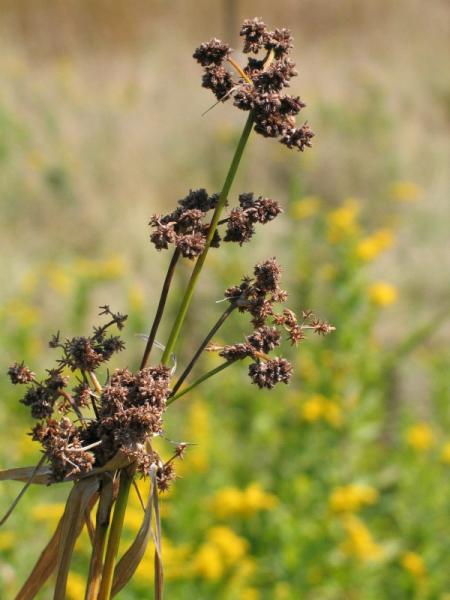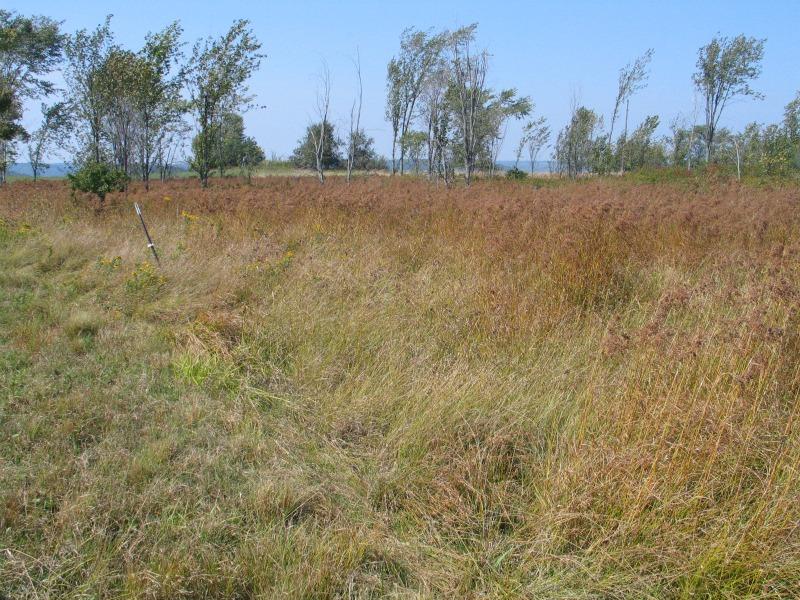Georgia Bulrush
Scirpus georgianus Harper
- Class
- Monocotyledoneae (Monocots)
- Family
- Cyperaceae (Sedge Family)
- State Protection
- Endangered
Listed as Endangered by New York State: in imminent danger of extirpation in New York. For animals, taking, importation, transportation, or possession is prohibited, except under license or permit. For plants, removal or damage without the consent of the landowner is prohibited.
- Federal Protection
- Not Listed
- State Conservation Status Rank
- S1S2
Critically Imperiled or Imperiled in New York - Especially or very vulnerable to disappearing from New York due to rarity or other factors; typically 20 or fewer populations or locations in New York, very few individuals, very restricted range, few remaining acres (or miles of stream), and/or steep declines. More information is needed to assign either S1 or S2.
- Global Conservation Status Rank
- G5
Secure globally - Common in the world; widespread and abundant (but may be rare in some parts of its range).
Summary
Did you know?
Although Georgia Bulrush is named after the state of Georgia it is known from as far north as Prince Edward Island, Canada (Harper 1900, Whittemore and Schuyler 2002).
State Ranking Justification
Scirpus georgianus is close to the northern part of its range in New York. It is only known to occur in widely scattered disjunct populations in the northern part of its range even though there is ample available habitat (Whittemore and Schuyler 2002, New York Natural Heritage Program 2007). There are currently 6 known extant populations although 3 of these have not been seen in nearly 20 years. There are 14 populations which have not been seen in at least 30 years and are considered historical. Additionally, 3 populations are believed to have become extirpated. Some of the historical occurrences may be based on misidentified specimens as the synonym S. atrovirens var. georgianus was long mis-applied to the common S. hattorianus.
Short-term Trends
One population has become extirpated within the past 40 years probably as a result of invasive plants. All of the six known extant populations were first found within the past twenty years. Since this species was misunderstood in the past and because it is often overlooked these "new" populations may have simply been overlooked in the past. Habitat for this species is probably not a limiting factor since the habitat that it prefers is generally relatively common at least in parts of New York. Overall, short term trends are not clear.
Long-term Trends
There are 14 populations which have not been seen in over 30 years, 10 of which, have not been seen in about 90 years. Some of these populations may be based on mid-identifications of closely related species. Two of the historical populations are from what is now highly urbanized regions around New York City and are likely extirpated. An additional 3 populations have become extirpated. Some "new" populations have been found in recent years but may have simply been overlooked in the past. Habitat for this species has declined around the urbanized New York City region and perhaps in other regions of New York State as a result of invasive species but in general adequate habitat is still relatively common although not-necessarily a limiting factor for Georgia bulrush. Overall, long term trends are not clear but may indicate at least some decline.
Conservation and Management
Threats
One population appears to have been extirpated as the result of the invasive plant common reed (Phragmites australis ssp. australis). An extant population is potentially threatened by the invasive reed Canary grass (Phalaris arundinacea). A few populations which occur (at least historically) in the New York City metropolitan region are likely threatened by urban development. Threats to other populations are not known.
Conservation Strategies and Management Practices
Keep an eye on invasive species which may be negatively impacting some populations. If these become a problem they should be controlled.
Research Needs
First, the identification of all voucher specimens should be confirmed. Historical populations should be searched for to determine if they are still extant. All known extant populations should be monitored on a regular basis.
Habitat
Habitat
Scirpus georgianus occurs in full sun in mesic to damp fields/meadows, edges of wet forests, and edges of marshes (New York Natural Heritage Program 2007). Moist meadows, marshes, and ditches (Whittemore and Schuyler 2002).
Associated Ecological Communities
- Cropland/field crops
An agricultural field planted in field crops such as alfalfa, wheat, timothy, and oats. This community includes hayfields that are rotated to pasture.
- Pastureland
Agricultural land permanently maintained (or recently abandoned) as a pasture area for livestock.
- Shallow emergent marsh
(guide)
A marsh meadow community that occurs on soils that are permanently saturated and seasonally flooded. This marsh is better drained than a deep emergent marsh; water depths may range from 6 in to 3.3 ft (15 cm to 1 m) during flood stages, but the water level usually drops by mid to late summer and the soil is exposed during an average year.
Associated Species
- Agrostis gigantea (red-top)
- Carex lupulina (hop sedge)
- Carex lurida (sallow sedge)
- Carex scoparia (pointed broom sedge)
- Carex tribuloides
- Carex vulpinoidea (fox sedge)
- Epilobium coloratum (eastern willow-herb)
- Euthamia graminifolia (common flat-topped-goldenrod)
- Ilex verticillata (common winterberry)
- Juncus effusus var. solutus
- Persicaria sagittata (arrow-leaved tear-thumb)
- Phalaris arundinacea (reed canary grass)
- Phleum pratense
- Scirpus cyperinus (common wool-grass)
- Scirpus hattorianus (mosquito bulrush)
- Solanum dulcamara (bitter-sweet nightshade)
- Solidago altissima
- Solidago rugosa
Range
New York State Distribution
There are scattered populations known from western New York, east to Lake Champlain, and south through the Hudson Valley to Long Island. It may also occur in northern New York, but specimens from that area need to be confirmed.
Global Distribution
This species occurs from Prince Edward Island south to Georgia and west to Ontario, Minnesota, Nebraska, and Texas. It occurs in disjunct localities in the northern part of its range (Whittemore and Schuyler 2002).
Identification Comments
General Description
Georgia bulrush is a grass-like plant with erect to reclining stems and strap-like leaves. The plants grow in clumps with leaves scattered along the stems. Numerous stalked clusters of tiny non-showy flowers occur at the summits of the stems. The flower clusters are ball-shaped. The flowers mature into tiny one-seeded fruits which eventually fall from the plants (Whittemore and Schuyler 2002).
Best Life Stage for Proper Identification
Mature fruits are nearly essential to the identification of this species although with enough familiarity young fruits or flowers are adequate.
Similar Species
The key character which separates Scirpus georgianus from other closely related species (S. atrovirens, S. hattorianus) is the perianth bristles which are either absent or limited to 3 and if present are short (mostly less than 0.2 times the length of the achenes) and smooth. Rarely, some achenes can be found with bristles up to 0.75 times the length of the achene. Also, sometimes the bristles (if present) can have a few barbs near their tips. Scirpus atrovirens and S. hattorianus have 5-6 perianth bristles per achene which are slightly shorter (0.6-0.8 times the length of the achenes) to longer than the achenes and are barbed distally. Care must be taken not to mistake the filaments (which have lost their anthers) for the bristles. There are only 3 filaments per achene and these are wider than the bristles and never barbed (Whittemore and Schuyler 2002).
The leaves of S. georgianus are 6-13 mm wide while the leaves of S. hattorianus are 5-9 mm wide and the leaves of S. atrovirens are 7-17 mm wide (Whittemore and Schuyler 2002).
Hybrids between S. georgianus and other closely related species are known. These hybrids can be distinguished by most of their ovaries being empty and having elongated spikelets.
Best Time to See
Georgia bulrush is conspicuous from mid-June through mid-October. It starts fruiting in late July or early August and fruits persist till mid-October. Since mature fruiting specimens are needed to identify this species, the best time to survey for this species is from mid-August till mid-October.
- Fruiting
The time of year you would expect to find Georgia Bulrush fruiting in New York.
Georgia Bulrush Images
Taxonomy
Georgia Bulrush
Scirpus georgianus Harper
- Kingdom Plantae
- Phylum Anthophyta
- Class Monocotyledoneae
(Monocots)
- Order Cyperales
- Family Cyperaceae (Sedge Family)
- Order Cyperales
- Class Monocotyledoneae
(Monocots)
- Phylum Anthophyta
Additional Common Names
- Bulrush
Synonyms
- Scirpus atrovirens var. georgianus (Harper) Fern. [in part.]
Comments on the Classification
Scirpus georgianus was originally described by Harper (1900). Fernald (1921, 1970), perhaps confusing S. georgianus with the yet to be described S. hattorianus placed S. georgianus as a variety of S. atrovirens (S. atrovirens var. georgianus) (Schuyler 1967). Since Fernald's concept of S. georgianus (as S. atrovirens var. georgianus) is inaccurate, his eighth edition of Gray's Manual of Botany (Fernald 1970) should not be used in the identification of S. georgianus. Gleason and Cronquist (1991) consider S. atrovirens a highly variable taxon and relegate S. georgianus to synonymy. Still, they do mention one character that distinguishes S. georgianus from S. atrovirens. Most old reports of S. atrovirens var. georgianus from northeastern United States and adjacent Canada are based on specimens of S. hattorianus (Whittemore and Schuyler 2002). Recent authors (Whittemore and Schuyler 2002, Weldy and Werier 2005, Weakley 2007) recognize S. georgianus at the species level. Schuyler (1967) found three different chromosome counts for S. georgianus but these differences were not associated with distinct morphological differences. Scirpus georgianus occasionally hybridizes with S. atrovirens and S. hattorianus (Whittemore and Schuyler 2002).
Additional Resources
Best Identification Reference
Whittemore, A.T. and A.E. Schuyler. 2002. Scirpus Linnaeus. Pages 8-21 in Flora of North America Editorial Committee (Editors), Flora of North America, North of Mexico, Volume 23, Magnoliophyta: Commelinidae (in part): Cyperaceae. Oxford University Press, New York, New York, USA.
Other References
Crow, Garrett E. and C. Barre Hellquist. 2000. Aquatic and wetland plants of northeastern North America: A revised and enlarged edition or Norman C. Fassett's a manual of aquatic plants. Volume two angiosperms: Monocotyledons. The University of Wisconsin Press. Madison, Wisconsin. 456 pp.
Fernald, M.L. 1921. The Gray herbarium expedition to Nova Scotia. Rhodora 23: 130-152.
Fernald, M.L. 1950. Gray's manual of botany. 8th edition. D. Van Nostrand, New York. 1632 pp.
Gleason, Henry A. and A. Cronquist. 1991. Manual of Vascular Plants of Northeastern United States and Adjacent Canada. The New York Botanical Garden, Bronx, New York. 910 pp.
Harper, R.M. 1900. Notes of the Flora of Middle Georgia. Bulletin of the Torrey Botanical Club 27: 320-441.
Holmgren, Noel. 1998. The Illustrated Companion to Gleason and Cronquist's Manual. Illustrations of the Vascular Plants of Northeastern United States and Adjacent Canada. The New York Botanical Garden, Bronx, New York.
New York Natural Heritage Program. 2010. Biotics database. New York Natural Heritage Program. New York State Department of Environmental Conservation. Albany, NY.
New York Natural Heritage Program. 2024. New York Natural Heritage Program Databases. Albany, NY.
Rhoads, Ann F. and Timothy A. Block. 2000. The Plants of Pennsylvania, an Illustrated Manual. University of Pennsylvania Press, Philadelphia, PA.
Schuyler, A.E. 1967. A taxonomic revision of North American leafy species of Scirpus. Proc. National Academy of Sciences, Philadelphia. 119:295-323.
Weldy, T. and D. Werier. 2010. New York flora atlas. [S.M. Landry, K.N. Campbell, and L.D. Mabe (original application development), Florida Center for Community Design and Research http://www.fccdr.usf.edu/. University of South Florida http://www.usf.edu/]. New York Flora Association http://newyork.plantatlas.usf.edu/, Albany, New York
Weldy, Troy W. and David Werier. 2005. New York Flora Atlas. [S.M. Landry, K.N. Campbell, and L.D. Mabe (original application development), Florida Center for Community Design and Research. University of South Florida]. New York Flora Association, Albany, NY. Available on the web at (http://newyork.plantatlas.usf.edu/).
Links
About This Guide
Information for this guide was last updated on: December 29, 2008
Please cite this page as:
New York Natural Heritage Program. 2024.
Online Conservation Guide for
Scirpus georgianus.
Available from: https://guides.nynhp.org/georgia-bulrush/.
Accessed July 26, 2024.


